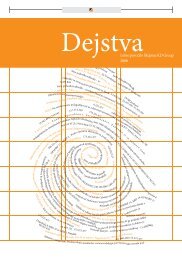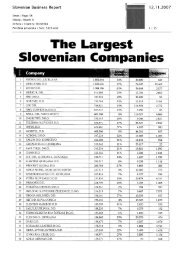<strong>The</strong> <strong>Group</strong> <strong>KD</strong> <strong>Group</strong> Annual Report 2009 Notes to Consolidated Financial Statements as at <strong>and</strong> for the year ended 31 December 2009 5.2.2 Credit risk Credit risk is the consequence of an inability on the part of a contracting party to fully repay its obligations or overdue debts. In terms of financial instruments included in investments, it is the risk that one party in a contract regulating the financial instrument will cause the other party to incur financial loss due to a default on obligations as a result of a difference between actual <strong>and</strong> contractually agreed fulfilment of obligations. <strong>The</strong> <strong>Group</strong> manages its credit risk exposure by introducing further limits on individual amounts <strong>and</strong> on already specified amounts of maximum exposure of individual securities. In order to minimise the risk exposure, the <strong>Group</strong> checks analyses <strong>and</strong> credit rating scores of issuers of securities. It also manages its credit risk exposure through investments in governmentissued securities, <strong>and</strong> low-risk securities. <strong>The</strong> procedures for checking the credit of foreign issuers of securities are based on acquiring credit rating information from international firms such as St<strong>and</strong>ard & Poor’s, Fitch-IBCA <strong>and</strong> Moody’s. Issuers of securities in Slovenia do not have ratings, but the insurance part of the <strong>Group</strong> has the highest concentration of investments in debt securities, bank <strong>and</strong> government bonds. <strong>The</strong> credit risk of investment coupons <strong>and</strong> equity securities is controlled by diversification of investments. Procedures of verifying credit ratings are based on obtaining <strong>and</strong> reviewing publicly accessible data on the current financial status of the issuer of financial instruments <strong>and</strong> its future solvency. <strong>The</strong> credit rating of domestic issuers of financial instruments is determined by the <strong>Group</strong> itself. In checking the issuer’s credit using its own sources, the <strong>Group</strong> checks future solvency <strong>and</strong> in particular the issuer’s adequacy of expected future cash flows from regular activities, offset against the outflows for settlement of future liabilities. In terms of of reinsurance, the same as for financial asset investment, credit risk management procedures relate to verifying the reinsurer’s credit rating. In accordance with the credit risk management strategy , reinsurance-related liabilities are reinsured by prime-grade reinsurers. This does not, however, discharge the <strong>Group</strong>’s liability as primary insurer. If a reinsurer fails to pay a claim for any reason, the <strong>Group</strong> remains liable for the payment to the policyholder. <strong>The</strong> creditworthiness of reinsurers is considered on an annual basis by reviewing their financial strength prior to finalisation of any contract. <strong>The</strong> <strong>Group</strong> restructures credit risk by establishing limits according to counterparty <strong>and</strong> also according to territory <strong>and</strong> industry. <strong>The</strong>se risks change regularly. Maximum credit risk at 31 December 2009 <strong>and</strong> 31 December 2008 (in EUR) AAA-A BBB-B Without rating Total 31.12.2009 31.12.2008 31.12.2009 31.12.2008 31.12.2009 31.12.2008 31.12.2009 31.12.2008 Debt securities 115,475,032 104,386,884 19,168,798 6,556,381 43,083,795 37,199,640 177,727,625 148,142,905 At fair value through profit or loss 816,754 1,399,763 3,576,692 1,000,419 19,316,040 17,261,803 23,709,486 19,661,985 Available-for-sale 107,886,926 100,486,158 10,611,753 3,990,928 17,224,175 16,159,125 135,722,854 120,636,211 Hel-to-maturity 6,771,352 2,500,963 4,980,353 1,565,034 6,543,580 3,778,712 18,295,285 7,844,709 Loans <strong>and</strong> receivables 3,147,557 - 9,860,032 - 148,794,675 181,421,807 161,802,264 181,421,807 Loans <strong>and</strong> deposits 3,147,557 - 9,860,032 - 79,010,288 97,783,106 92,017,877 97,783,106 Insurance receivables - - - - 33,377,192 35,709,836 33,377,192 35,709,836 Recourse receivables - - - - 10,713,323 11,768,663 10,713,323 11,768,663 Other receivables - - - - 25,693,872 36,160,202 25,693,872 36,160,202 Reinsurance assets - - - - 19,449,008 17,362,703 19,449,008 17,362,703 Cash <strong>and</strong> cash equivalents 491,776 5,745 46,620 70,932 40,191,676 31,228,515 40,730,072 31,305,192 Total assets 119,114,365 104,392,629 29,075,450 6,627,313 251,519,154 267,212,665 399,708,969 378,232,607 130
<strong>The</strong> <strong>Group</strong> <strong>KD</strong> <strong>Group</strong> Annual Report 2009 Notes to Consolidated Financial Statements as at <strong>and</strong> for the year ended 31 December 2009 Recourse receivables – recourse claims <strong>and</strong> assets acquired in the course of settlement of claims <strong>The</strong> <strong>Group</strong> may sell items damaged in insurance cases, which it acquires in the course of resolving claims. <strong>The</strong> net recoverable value of damaged items in claims which the <strong>Group</strong> manages to sell is recognised as revenue on the transaction date (sale of the damaged item). With the payment of claims, the rights in relation to those responsible for the damage are also transferred from the policyholder to the <strong>Group</strong> (subrogation). <strong>The</strong> <strong>Group</strong> exercises that right through a recourse claim of partial or entire payment of the insurance amount. In the event the insured person of compulsory liability insurance loses his or her rights (intoxication, etc.) the <strong>Group</strong> dem<strong>and</strong>s recourse from the policyholder or the person responsible for the damage of the entire or partial amount of the paid claims. Exercised recourse claims are recognised as insurance revenue. Expected recourse amounts are also included in the calculation of liabilities for claims. Recourse receivables are recorded separately, as exercised <strong>and</strong> unexercised, whereas the unexercised recourse receivables are kept in off-balance sheet records <strong>and</strong> no impairment is recognised with regard to them. Exercised recourse receivables are recorded separately as receivables insured by mortgage <strong>and</strong> other recourse receivables, which is the basis for impairment calculation. Impairment of exercised recourse receivables <strong>and</strong> receivables on redemption is based on individual estimation of the financial situation <strong>and</strong> liquidity of the insurance policyholder. Liquidity of debtors <strong>and</strong> other receivables, except deferred tax receivables, are assessed individually; the same is true for impairment calculation. Loans <strong>The</strong> <strong>Group</strong> approves loans to its subsidiaries <strong>and</strong> associates in order to take advantage of synergy effects. <strong>The</strong> <strong>Group</strong> can raise loans under more advantageous conditions than subsidiaries <strong>and</strong> associates because of its financial power <strong>and</strong> intensive cooperation with financial institutions. Loans are approved at the rate of interest prescried for loans to related parties. Loans are not insured. In some cases, loans are also approved to companies outside the <strong>Group</strong> if there exists a mutual interest for business cooperation. <strong>The</strong>se loans are not insured, <strong>and</strong> the interest rate is higher. 131







